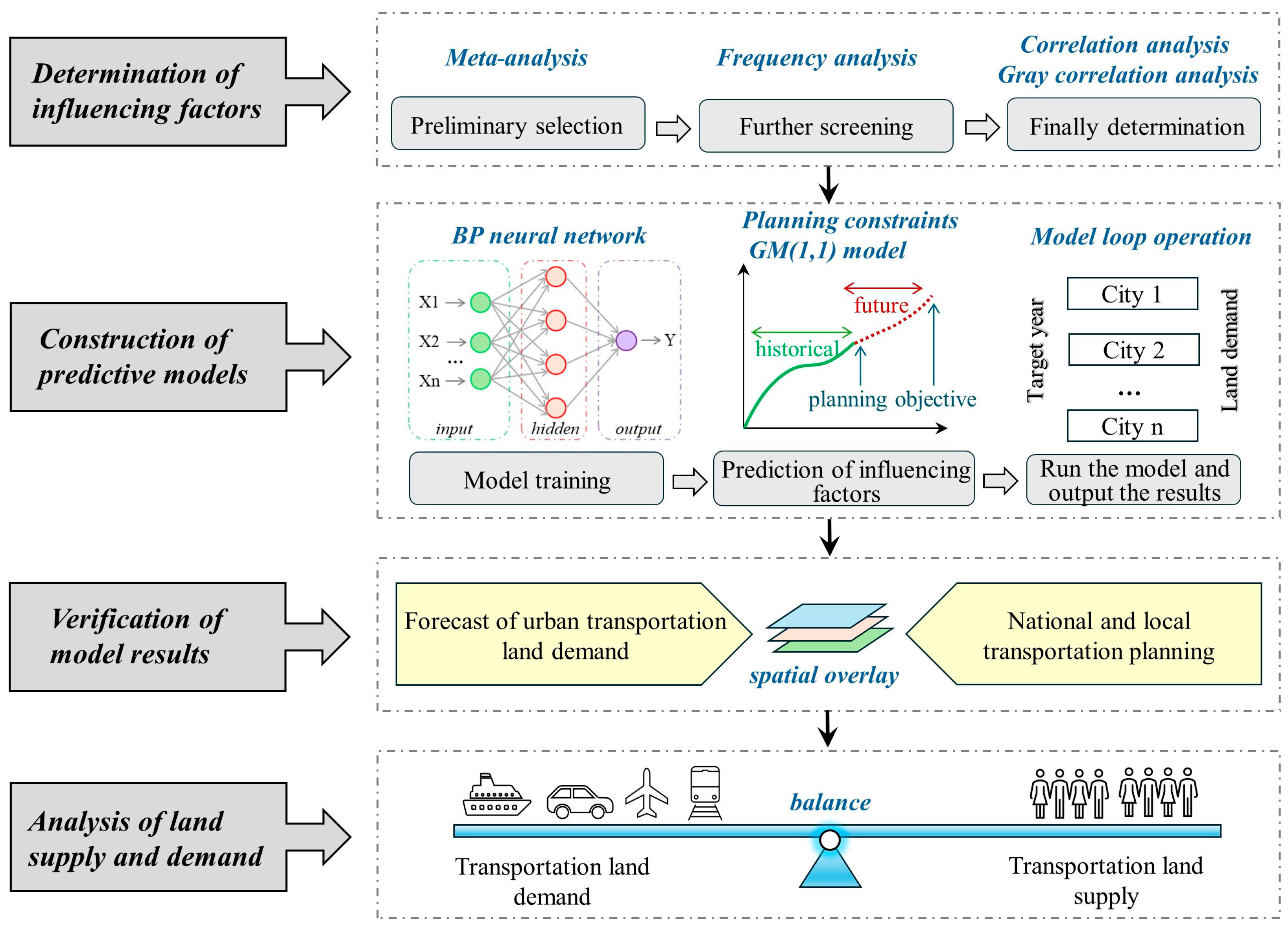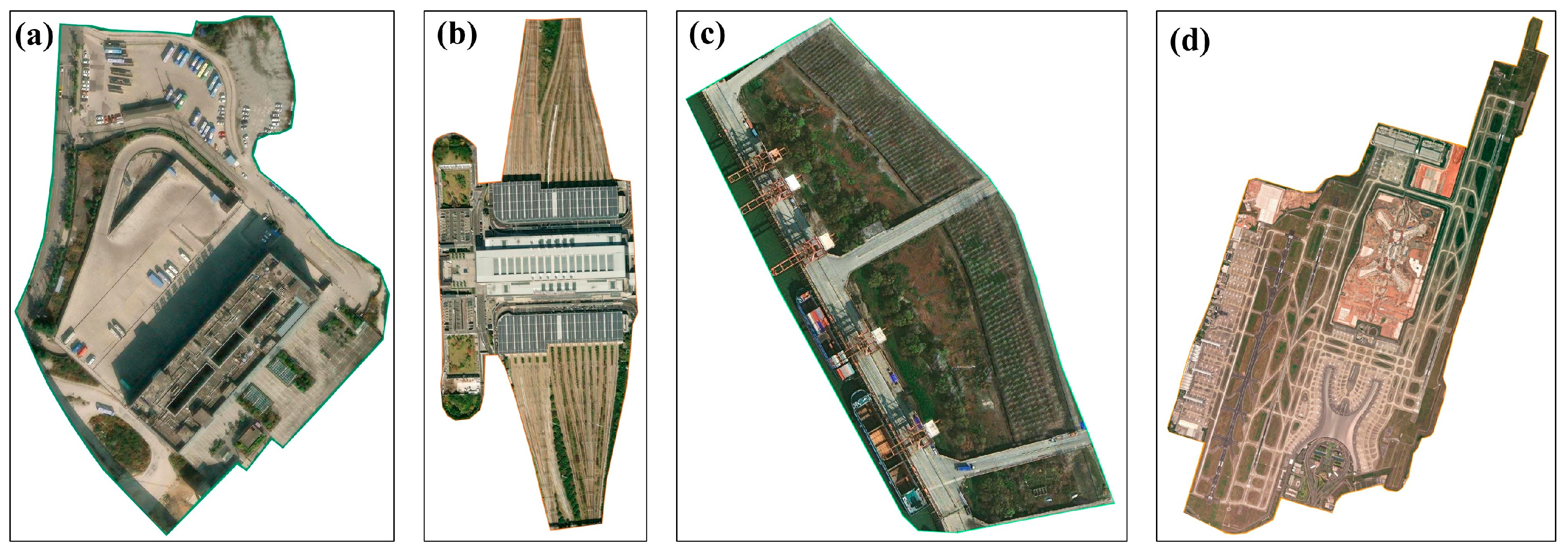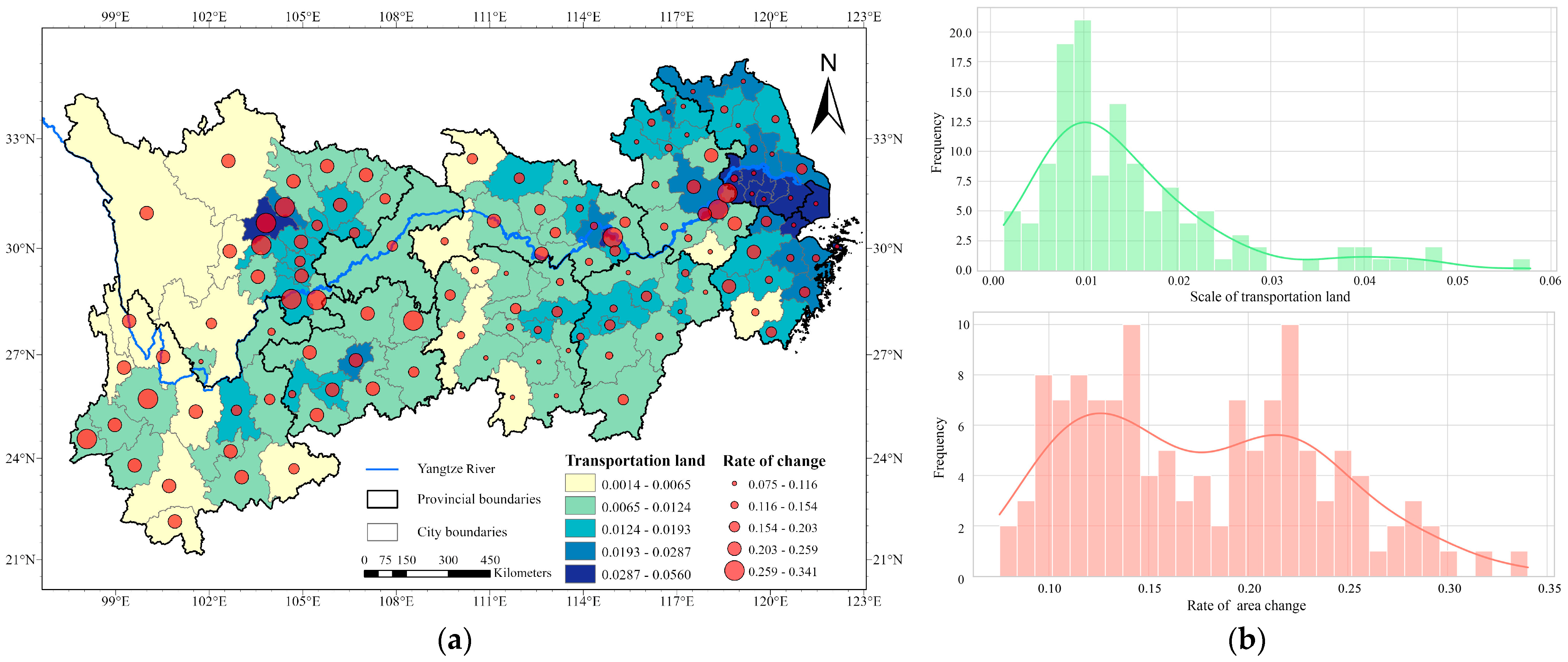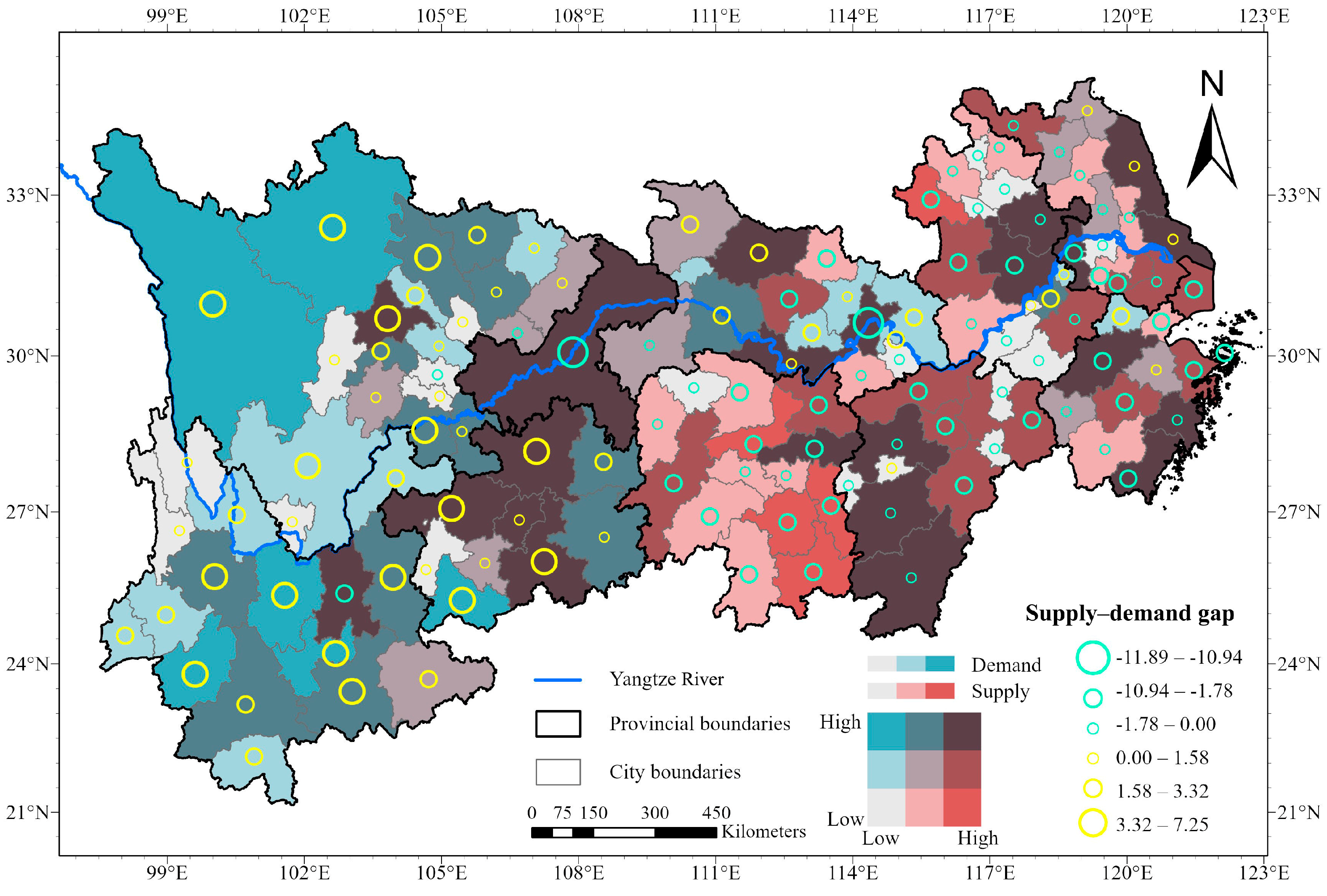Towards a Comprehensive Framework for Regional Transportation Land Demand Forecasting: Empirical Study from Yangtze River Economic Belt, China
Abstract
:1. Introduction
2. Materials and Methods
2.1. Overview of the Study Area
2.2. Policy Timeline for the Transportation Development of the YREB
2.3. Considerations for the Study Framework
2.4. Data Sources
2.5. Method
2.5.1. Determination of Main Factors Affecting Transportation Land Demand
- (1)
- Methodology of the systematic literature review
- (2)
- Grey correlation analysis
2.5.2. Construction of Land Demand Forecasting Model of Gray–BP Neural Network under the Constraints of Planning Objectives
- BP neural network model
- 2.
- GM(1,1) prediction model
3. Results
3.1. Main Factors Affecting Transportation Land Demand
3.2. Forecasting Urban Transportation Land Demand in the YREB
3.2.1. An Empirical Result of Urban Transportation Land Demand Forecasting Models—Shanghai Example
3.2.2. Comparative Analysis of the Differential Characteristics of Urban Transportation Land Demand in the YREB
3.3. Validation of the Reasonableness of the Forecasted Results
3.4. Analysis of Supply and Demand of Urban Transportation Land in the YREB
4. Discussion
4.1. Implications and Applications
4.2. Limitations and Prospects
5. Conclusions
Author Contributions
Funding
Data Availability Statement
Acknowledgments
Conflicts of Interest
References
- Chen, G.; Li, X.; Liu, X.; Chen, Y.; Liang, X.; Leng, J.; Xu, X.; Liao, W.; Qiu, Y.a.; Wu, Q.; et al. Global projections of future urban land expansion under shared socioeconomic pathways. Nat. Commun. 2020, 11, 537. [Google Scholar] [CrossRef] [PubMed]
- Schuckmann, S.W.; Gnatzy, T.; Darkow, I.-L.; von der Gracht, H.A. Analysis of factors influencing the development of transport infrastructure until the year 2030—A Delphi based scenario study. Technol. Forecast. Soc. Chang. 2012, 79, 1373–1387. [Google Scholar] [CrossRef]
- Laurance, W.F.; Clements, G.R.; Sloan, S.; O’Connell, C.S.; Mueller, N.D.; Goosem, M.; Venter, O.; Edwards, D.P.; Phalan, B.; Balmford, A.; et al. A global strategy for road building. Nature 2014, 513, 229–232. [Google Scholar] [CrossRef] [PubMed]
- Dulac, J. Global Land Transport Infrastructure Requirements: Estimating Road and Railway Infrastructure Capacity and Costs to 2050; International Energy Agency: Paris, France, 2013. [Google Scholar]
- Zeng, L.; Li, H.; Wang, X.; Yu, Z.; Hu, H.; Yuan, X.; Zhao, X.; Li, C.; Yuan, D.; Gao, Y. China’s transport land: Spatiotemporal expansion characteristics and driving mechanism. Land 2022, 11, 1147. [Google Scholar] [CrossRef]
- Li, C.; Wu, K.; Gao, X. Manufacturing industry agglomeration and spatial clustering: Evidence from Hebei Province, China. Environ. Dev. Sustain. 2020, 22, 2941–2965. [Google Scholar] [CrossRef]
- Huang, Z.; Du, X. Government intervention and land misallocation: Evidence from China. Cities 2017, 60, 323–332. [Google Scholar] [CrossRef]
- Ewing, R.; Bartholomew, K. Comparing Land Use Forecasting Methods: Expert Panel versus Spatial Interaction Model. J. Am. Plan. Assoc. 2009, 75, 343–357. [Google Scholar] [CrossRef]
- Han, H.; Yang, C.; Song, J. Scenario Simulation and the Prediction of Land Use and Land Cover Change in Beijing, China. Sustainability 2015, 7, 4260–4279. [Google Scholar] [CrossRef]
- Li, B.; Cao, X.; Xu, J.; Wang, W.; Ouyang, S.; Liu, D. Spatial–Temporal Pattern and Influence Factors of Land Used for Transportation at the County Level since the Implementation of the Reform and Opening-Up Policy in China. Land 2021, 10, 833. [Google Scholar] [CrossRef]
- Aljoufie, M. Toward an effective analysis of public transportation demand factors in car-dependent cities: Case of Makkah City, Saudi Arabia. Urban Plan. Transp. Res. 2021, 9, 257–275. [Google Scholar] [CrossRef]
- Ma, L.; Liang, J.; Gao, D.; Sun, J.; Li, Z. The Future Demand of Transportation in China: 2030 Scenario based on a Hybrid Model. Procedia—Soc. Behav. Sci. 2012, 54, 428–437. [Google Scholar] [CrossRef]
- Magazzino, C.; Mele, M. On the relationship between transportation infrastructure and economic development in China. Res. Transp. Econ. 2020, 88, 100947. [Google Scholar] [CrossRef]
- Pradhan, R.P.; Bagchi, T.P. Effect of transportation infrastructure on economic growth in India: The VECM approach. Res. Transp. Econ. 2013, 38, 139–148. [Google Scholar] [CrossRef]
- Banerjee, A.; Duflo, E.; Qian, N. On the road: Access to transportation infrastructure and economic growth in China. J. Dev. Econ. 2020, 145, 102442. [Google Scholar] [CrossRef]
- Du, Q.; Wang, X.; Li, Y.; Zou, P.X.W.; Han, X.; Meng, M. An analysis of coupling coordination relationship between regional economy and transportation: Empirical evidence from China. Environ. Sci. Pollut. Res. 2022, 29, 34360–34378. [Google Scholar] [CrossRef]
- Liddle, B. Long-run relationship among transport demand, income, and gasoline price for the US. Transp. Res. Part D Transp. Environ. 2009, 14, 73–82. [Google Scholar] [CrossRef]
- Kim, E. Determinants of Optimal Level of Transportation Infrastructure. J. Urban Plan. Dev. 2002, 128, 150–163. [Google Scholar] [CrossRef]
- Fisch-Romito, V.; Guivarch, C. Transportation infrastructures in a low carbon world: An evaluation of investment needs and their determinants. Transp. Res. Part D Transp. Environ. 2019, 72, 203–219. [Google Scholar] [CrossRef]
- Feng, X.; Sun, Q.; Qian, K.; Liu, M. Cointegration Relationship of Regional Integrated Transport Demand and Industrial Structure. J. Transp. Syst. Eng. Inf. Technol. 2012, 12, 10–16. [Google Scholar] [CrossRef]
- Albalate, D.; Fageda, X. High-Technology Employment and Transportation: Evidence from the European Regions. Reg. Stud. 2016, 50, 1564–1578. [Google Scholar] [CrossRef]
- Maparu, T.S.; Mazumder, T.N. Transport infrastructure, economic development and urbanization in India (1990–2011): Is there any causal relationship? Transp. Res. Part A Policy Pract. 2017, 100, 319–336. [Google Scholar] [CrossRef]
- Yang, Z.; Jia, P.; Liu, W.; Yin, H. Car ownership and urban development in Chinese cities: A panel data analysis. J. Transp. Geogr. 2017, 58, 127–134. [Google Scholar] [CrossRef]
- Asher, S.; Garg, T.; Novosad, P. The Ecological Impact of Transportation Infrastructure. Econ. J. 2020, 130, 1173–1199. [Google Scholar] [CrossRef]
- Xi, F.; He, H.S.; Hu, Y.; Bu, R.; Chang, Y.; Wu, X.; Liu, M.; Shi, T. Simulating the impacts of ecological protection policies on urban land use sustainability in Shenyang-Fushun, China. Int. J. Urban Sustain. Dev. 2009, 1, 111–127. [Google Scholar] [CrossRef]
- Mishalani, R.G.; Goel, P.K.; Westra, A.M.; Landgraf, A.J. Modeling the relationships among urban passenger travel carbon dioxide emissions, transportation demand and supply, population density, and proxy policy variables. Transp. Res. Part D Transp. Environ. 2014, 33, 146–154. [Google Scholar] [CrossRef]
- Xiong, Y.; Chen, Y.; Peng, F.; Li, J.; Yan, X. Analog simulation of urban construction land supply and demand in Chang-Zhu-Tan Urban Agglomeration based on land intensive use. J. Geogr. Sci. 2019, 29, 1346–1362. [Google Scholar] [CrossRef]
- Plakandaras, V.; Papadimitriou, T.; Gogas, P. Forecasting transportation demand for the U.S. market. Transp. Res. Part A Policy Pract. 2019, 126, 195–214. [Google Scholar] [CrossRef]
- Benjamin, J. A time-series forecast of average daily traffic volume. Transp. Res. Part A Gen. 1986, 20, 51–60. [Google Scholar] [CrossRef]
- Mrówczyńska, B.; Łachacz, K.; Haniszewski, T.; Sładkowski, A. A comparison of forecasting the results of road transportation needs. Transport 2012, 27, 73–78. [Google Scholar] [CrossRef]
- Li, Z.; Hensher, D.A. Toll Roads in Australia: An Overview of Characteristics and Accuracy of Demand Forecasts. Transp. Rev. 2010, 30, 541–569. [Google Scholar] [CrossRef]
- Li, C.; Gao, X.; Wu, J.; Wu, K. Demand prediction and regulation zoning of urban-industrial land: Evidence from Beijing-Tianjin-Hebei Urban Agglomeration, China. Environ. Monit. Assess. 2019, 191, 412. [Google Scholar] [CrossRef] [PubMed]
- Batista e Silva, F.; Koomen, E.; Diogo, V.; Lavalle, C. Estimating Demand for Industrial and Commercial Land Use Given Economic Forecasts. PLoS ONE 2014, 9, e91991. [Google Scholar] [CrossRef] [PubMed]
- Shi, Y.; Li, M.; Fu, Y.; Wang, L.; Sun, M.; Hao, J. Multi-scenario traffic land demand forecasting based on grey system-BP neural network model: A case study of urban agglomeration in the middle reaches of the Yangtze River. J. China Agric. Univ 2020, 25, 142–153. [Google Scholar] [CrossRef]
- Jun, M.-J. Forecasting Urban Land-Use Demand Using a Metropolitan Input-Output Model. Environ. Plan. A Econ. Space 2005, 37, 1311–1328. [Google Scholar] [CrossRef]
- Xiao, J.; Shen, Y.; Ge, J.; Tateishi, R.; Tang, C.; Liang, Y.; Huang, Z. Evaluating urban expansion and land use change in Shijiazhuang, China, by using GIS and remote sensing. Landsc. Urban Plan. 2006, 75, 69–80. [Google Scholar] [CrossRef]
- Pastorino, M.; Gallo, F.; Di Febbraro, A.; Moser, G.; Sacco, N.; Serpico, S.B. Multimodal Fusion of Mobility Demand Data and Remote Sensing Imagery for Urban Land-Use and Land-Cover Mapping. Remote Sens. 2022, 14, 3370. [Google Scholar] [CrossRef]
- Hoymann, J. Quantifying demand for built-up area—A comparison of approaches and application to regions with stagnating population. J. Land Use Sci. 2012, 7, 67–87. [Google Scholar] [CrossRef]
- Jiang, H.; Guo, H.; Sun, Z.; Xing, Q.; Zhang, H.; Ma, Y.; Li, S. Projections of urban built-up area expansion and urbanization sustainability in China’s cities through 2030. J. Clean. Prod. 2022, 367, 133086. [Google Scholar] [CrossRef]
- Erb, K.-H. Actual land demand of Austria 1926–2000: A variation on Ecological Footprint assessments. Land Use Policy 2004, 21, 247–259. [Google Scholar] [CrossRef]
- Jackson, L.E.; Bird, S.L.; Matheny, R.W.; O’Neill, R.V.; White, D.; Boesch, K.C.; Koviach, J.L. A Regional Approach to Projecting Land-Use Change and Resulting Ecological Vulnerability. Environ. Monit. Assess. 2004, 94, 231–248. [Google Scholar] [CrossRef]
- Lee, C.; Lee, S. Analyzing spatiotemporal land use change using an urban growth model based on multilevel logistic regression and future land demand scenarios. Appl. Geogr. 2023, 160, 103099. [Google Scholar] [CrossRef]
- Ustaoglu, E.; Batista e Silva, F.; Lavalle, C. Quantifying and modelling industrial and commercial land-use demand in France. Environ. Dev. Sustain. 2020, 22, 519–549. [Google Scholar] [CrossRef]
- Wang, L.; Wang, K.; Zhang, J.; Zhang, D.; Wu, X.; Zhang, L. Multiple objective-oriented land supply for sustainable transportation: A perspective from industrial dependence, dominance and restrictions of 127 cities in the Yangtze River Economic Belt of China. Land Use Policy 2020, 99, 105069. [Google Scholar] [CrossRef]
- Sun, H.; Chen, Y.Y.; Fan, Z.Q. Study the Residential Land Demand by Ridge Regression and Multiple Linear Regression. Key Eng. Mater. 2011, 467–469, 1250–1255. [Google Scholar] [CrossRef]
- Samardžić-Petrović, M.; Kovačević, M.; Bajat, B.; Dragićević, S. Machine Learning Techniques for Modelling Short Term Land-Use Change. ISPRS Int. J. Geo-Inf. 2017, 6, 387. [Google Scholar] [CrossRef]
- Pijanowski, B.C.; Brown, D.G.; Shellito, B.A.; Manik, G.A. Using neural networks and GIS to forecast land use changes: A Land Transformation Model. Comput. Environ. Urban Syst. 2002, 26, 553–575. [Google Scholar] [CrossRef]
- Aburas, M.M.; Ahamad, M.S.S.; Omar, N.Q. Spatio-temporal simulation and prediction of land-use change using conventional and machine learning models: A review. Environ. Monit. Assess. 2019, 191, 205. [Google Scholar] [CrossRef] [PubMed]
- Rogan, J.; Chen, D. Remote sensing technology for mapping and monitoring land-cover and land-use change. Prog. Plan. 2004, 61, 301–325. [Google Scholar] [CrossRef]
- Hu, X.; Li, Z.; Cai, Y.; Wu, F. Urban construction land demand prediction and spatial pattern simulation under carbon peak and neutrality goals: A case study of Guangzhou, China. J. Geogr. Sci. 2022, 32, 2251–2270. [Google Scholar] [CrossRef]
- Almeida, C.M.D.; Monteiro, A.M.V.; Câmara, G.; Soares-Filho, B.S.; Cerqueira, G.C.; Pennachin, C.L.; Batty, M. GIS and remote sensing as tools for the simulation of urban land-use change. Int. J. Remote Sens. 2005, 26, 759–774. [Google Scholar] [CrossRef]
- Warth, G.; Braun, A.; Assmann, O.; Fleckenstein, K.; Hochschild, V. Prediction of Socio-Economic Indicators for Urban Planning Using VHR Satellite Imagery and Spatial Analysis. Remote Sens. 2020, 12, 1730. [Google Scholar] [CrossRef]
- Needham, B.; Louw, E.; Metzemakers, P. An economic theory for industrial land policy. Land Use Policy 2013, 33, 227–234. [Google Scholar] [CrossRef]
- Zhou, L.; Tian, L.; Cao, Y.; Yang, L. Industrial land supply at different technological intensities and its contribution to economic growth in China: A case study of the Beijing-Tianjin-Hebei region. Land Use Policy 2021, 101, 105087. [Google Scholar] [CrossRef]
- Miller, P.; de Barros, A.G.; Kattan, L.; Wirasinghe, S.C. Public transportation and sustainability: A review. KSCE J. Civ. Eng. 2016, 20, 1076–1083. [Google Scholar] [CrossRef]
- Chen, Y.; Zhang, S.; Huang, D.; Li, B.-L.; Liu, J.; Liu, W.; Ma, J.; Wang, F.; Wang, Y.; Wu, S. The development of China’s Yangtze River Economic Belt: How to make it in a green way. Sci. Bull. 2017, 62, 648–651. [Google Scholar] [CrossRef] [PubMed]
- Moher, D.; Liberati, A.; Tetzlaff, J.; Altman, D.G. Preferred Reporting Items for Systematic Reviews and Meta-Analyses: The PRISMA Statement. Ann. Intern. Med. 2009, 151, 264–269. [Google Scholar] [CrossRef] [PubMed]
- Matthew, J.P.; Joanne, E.M.; Patrick, M.B.; Isabelle, B.; Tammy, C.H.; Cynthia, D.M.; Larissa, S.; Jennifer, M.T.; Elie, A.A.; Sue, E.B.; et al. The PRISMA 2020 statement: An updated guideline for reporting systematic reviews. BMJ 2021, 372, n71. [Google Scholar] [CrossRef] [PubMed]
- Wong, F.S. Time series forecasting using backpropagation neural networks. Neurocomputing 1991, 2, 147–159. [Google Scholar] [CrossRef]
- Guan, Q.; Wang, L.; Clarke, K.C. An Artificial-Neural-Network-based, Constrained CA Model for Simulating Urban Growth. Cartogr. Geogr. Inf. Sci. 2005, 32, 369–380. [Google Scholar] [CrossRef]
- Ju-Long, D. Control problems of grey systems. Syst. Control. Lett. 1982, 1, 288–294. [Google Scholar] [CrossRef]
- Ding, C. Land policy reform in China: Assessment and prospects. Land Use Policy 2003, 20, 109–120. [Google Scholar] [CrossRef]
- Zander, P.; Kächele, H. Modelling multiple objectives of land use for sustainable development. Agric. Syst. 1999, 59, 311–325. [Google Scholar] [CrossRef]
- Mao, X.; Huang, X.; Song, Y.; Zhu, Y.; Tan, Q. Response to urban land scarcity in growing megacities: Urban containment or inter-city connection? Cities 2020, 96, 102399. [Google Scholar] [CrossRef]
- Ren, Y.; Tian, Y.; Xiao, X. Spatial effects of transportation infrastructure on the development of urban agglomeration integration: Evidence from the Yangtze River Economic Belt. J. Transp. Geogr. 2022, 104, 103431. [Google Scholar] [CrossRef]
- Jin, F.; Ding, J.; Wang, J.E.; Liu, D.; Wang, C. Transportation development transition in China. Chin. Geogr. Sci. 2012, 22, 319–333. [Google Scholar] [CrossRef]









| Search Term | Number of Publications from WoS | Number of Publications from CNKI | Search Date |
|---|---|---|---|
| TITLE ((Transportation OR Transport OR Traffic OR Highway OR Road OR Railway OR Airport OR Port) AND land) | 3170 | 885 | 6 November 2023 |
| Influencing Factors | Grey Relational Degree | Description |
|---|---|---|
| Economic development level (X1) | 0.85529 | GDP |
| Population size (X2) | 0.89608 | Number of individuals present |
| Investment (X3) | 0.90119 | Fixed-asset investment |
| Urban construction level (X4) | 0.88750 | Urban construction land area |
| Urbanization rate (X5) | 0.80576 | Ratio of urban population to total population |
| Industrial development (X6) | 0.87040 | Gross industrial output value |
| Income level (X7) | 0.83050 | Per capita disposable income |
| Consumption level (X8) | 0.85628 | Total retail sales of consumer goods |
| Industrial structure (X9) | 0.67864 | Ratio of secondary and tertiary industries to GDP |
| Employment (X10) | 0.85312 | Employed population |
| Factors 1 | Planned or Forecasted Value | Methods and Constraints |
|---|---|---|
| X1 | 49,392.84 | 14th Five-Year Plan |
| X2 | 2500 | City’s master plan |
| X3 | 3200 | Territorial spatial plan |
| X4 | 0.9 | GM (1,1) model |
| X5 | 39,136 | GM (1,1) model |
| X6 | 10,265.15 | GM (1,1) model |
| X7 | 1400 | GM (1,1) model |
| X8 | 20,000 | 14th Five-Year Plan |
| X9 | 98,648.39 | 14th Five-Year Plan |
| Transportation land area in 2025 | 346.16 | Gray–BP neural network model under planning constraints |
Disclaimer/Publisher’s Note: The statements, opinions and data contained in all publications are solely those of the individual author(s) and contributor(s) and not of MDPI and/or the editor(s). MDPI and/or the editor(s) disclaim responsibility for any injury to people or property resulting from any ideas, methods, instructions or products referred to in the content. |
© 2024 by the authors. Licensee MDPI, Basel, Switzerland. This article is an open access article distributed under the terms and conditions of the Creative Commons Attribution (CC BY) license (https://creativecommons.org/licenses/by/4.0/).
Share and Cite
Wang, K.; Wang, L.; Zhang, J. Towards a Comprehensive Framework for Regional Transportation Land Demand Forecasting: Empirical Study from Yangtze River Economic Belt, China. Land 2024, 13, 847. https://doi.org/10.3390/land13060847
Wang K, Wang L, Zhang J. Towards a Comprehensive Framework for Regional Transportation Land Demand Forecasting: Empirical Study from Yangtze River Economic Belt, China. Land. 2024; 13(6):847. https://doi.org/10.3390/land13060847
Chicago/Turabian StyleWang, Ke, Li Wang, and Jianjun Zhang. 2024. "Towards a Comprehensive Framework for Regional Transportation Land Demand Forecasting: Empirical Study from Yangtze River Economic Belt, China" Land 13, no. 6: 847. https://doi.org/10.3390/land13060847
APA StyleWang, K., Wang, L., & Zhang, J. (2024). Towards a Comprehensive Framework for Regional Transportation Land Demand Forecasting: Empirical Study from Yangtze River Economic Belt, China. Land, 13(6), 847. https://doi.org/10.3390/land13060847







